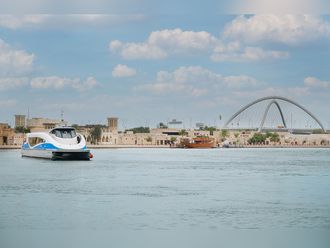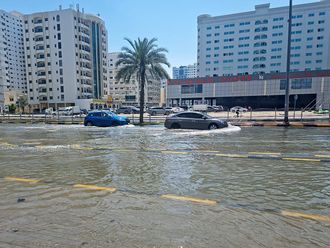As the UAE shakes up its education system to improve standards, it is looking at ways to integrate technology into the curriculum to make teaching and learning experiences in classrooms more interactive. This is particularly relevant for digital natives who have grown up surrounded by technology.
Understanding the importance of smart technology and that it will shape the future of education, His Highness Shaikh Mohammad Bin Rashid Al Maktoum, Vice-President and Prime Minister of the UAE and Ruler of Dubai, launched the Mohammad Bin Rashid Smart Learning Programme (MBRSLP) in 2012, which offers schools a new mode of teaching through the integration of technology into the education system.
Since its inception, the MBRSLP has been introducing smart classes in federal schools around the UAE with the ultimate goal of providing every government school student with a tablet device by 2019.
“Through a blended approach to teaching, the programme places students at the centre of the educational experience, while giving them an element of control and an active role as participants in their own learning process,” Mohammad Gheyath, Director-General, MBRSLP, tells GN Focus.
This year, the MBRSLP provided 3,543 laptops for teachers and 800 smart boards in classrooms, reaching 24,328 students across 146 schools in the UAE. The programme is aligned with the UAE Vision 2021, which seeks to transform the nation into a flexible and diversified knowledge-based economy.
What is a smart classroom?
Staying connected is critical for digital natives. That’s why in a typical smart classroom, which is always equipped with Wi-Fi, teachers use large smart boards similar to flat-screen computer monitors and students use tablets with keyboards or laptops.
Since the programme uses a blended approach, students are offered both the hard copy version of the curriculum — books for each subject — as well as the digital. “Online portals allow students to interact with each other on assignments and with their teachers for extra questions outside of the classroom,” Gheyath explains.
To revolutionise the classroom experience for students, most educational institutions in the UAE, and at all levels, have started to integrate smart learning tools into their curricula as it is also closely linked to the overall e-transformation of all government bodies, institutions and citizens.
“As students get more exposed to technology and become dependent on it, they look for innovations to meet their various academic needs. This makes governments and academic institutions realise the need to stay up to date with the latest technology in smart learning, in line with the changing needs of students,” points out Ahmad Ameen Ashour, Education Lead, Microsoft Gulf, which has partnered with the MBRSLP to equip classrooms with Windows 8.1 devices that have built-in education apps and touch-enabled content.
It is not only the federal schools that are adopting technology to engage students — private education institutes are also thinking outside the box and introducing smartphones, tablets and plenty of applications and features in classrooms to enhance learning.
Transforming the classroom
All Gems Education schools, the largest private education provider with 40 schools in the UAE, are equipped with cutting-edge technical infrastructure. “Students in our schools are reaping the benefits of successful Bring Your Own [Device] programmes, empowering them to learn anywhere and anytime, resulting in deeper and more meaningful learning experiences,” says Phil Redhead, Senior Adviser, Digital Learning, Gems Education.
Taaleem, another leading education group, also uses technology to accomplish classroom objectives. At its Uptown School, for example, Mac technology is embedded in every classroom, from kindergarten to Grade 10. “IPads are also available at the school to enhance learning opportunities,” says Clive Pierrepont, Director of Communications, Taaleem.
Owing to the massive penetration of smartphones, tablets and other mobile devices in the UAE, higher education institutes have begun taking a fresh approach to pedagogy. The demand for mobility is evident when looking at the solutions that implemented in the past few years.
For instance, The UAE University, along with Ellucian, built a complete mobile solution to tap into the increased mobile penetration among the student community. From keeping up to date with their class schedule, grades and attendance to offering campus-related information, the mobile application offers many benefits for student users.
“More than 5,000 users installed the app within the first few days and it currently receives almost one million views per month,” says Mathew Boice, Vice-President, Middle East and Africa, Ellucian, which offers a broad portfolio of technology solutions for the education sector.
The demand for cloud solutions, which are instrumental in furthering smart learning, is also rising. Many institutes have opted for cloud infrastructure to improve students’ experiences as well as faculty-student interactions.
“Cloud-based solutions also support anytime, anywhere, any device access to education materials, which is critical for today’s connected students and faculty,” adds Boice.
Assistive technology has also started to play a significant role in enhancing training and learning potential of students with special needs. “We have made systemic changes to make assistive technology an integral tool in our system, from curriculum and training to service delivery and resource mobilisation,” says Isphana Al Khatib, Director, Al Noor Training Centre for Children with Special Needs.
Motivating educators
As with any educational or technological change, the smart education revolution comes with its own risks and challenges.
“One of the significant challenges that we have encountered while rolling out our large-scale programmes is resistance from those who are either reluctant to embrace the new technology or wary of how effective it will be in improving learning outcomes,” explains Fadi Khalek, Vice-President, Strategic Partnerships and Efficacy, Pearson, which has worked closely with the UAE government and learning institutions and educators to implement smart learning technologies.
“Providing professional development and training opportunities for educators and administrators is essential to ensuring a successful transition to smart learning in institutions.”
Another barrier to change is the outdated public examination system. Redhead says,“There is a damaging disconnect between the knowledge, skills, values and attributes that educators and industry leaders want learners to acquire and how they are ultimately assessed.”
To make smart learning really take off, it is critical that assessment processes are aligned with learning outcomes. “There needs to be a concerted effort in partnership with policymakers, examination boards, universities and industry to develop authentic assessment models, which reflect the results we really want for our students,” Redhead explains.












